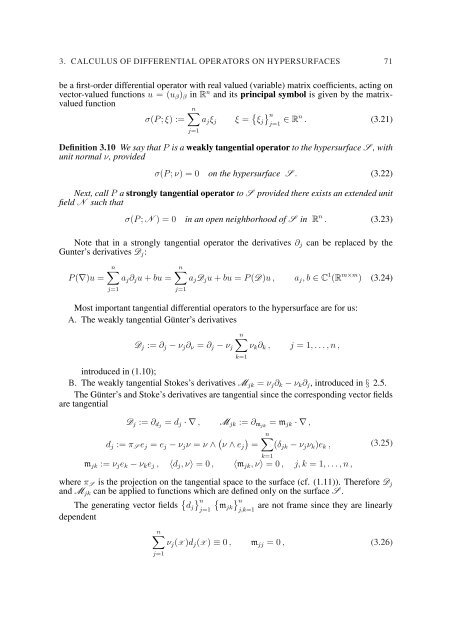EQUATIONS OF ELASTIC HYPERSURFACES
EQUATIONS OF ELASTIC HYPERSURFACES
EQUATIONS OF ELASTIC HYPERSURFACES
Create successful ePaper yourself
Turn your PDF publications into a flip-book with our unique Google optimized e-Paper software.
3. CALCULUS <strong>OF</strong> DIFFERENTIAL OPERATORS ON <strong>HYPERSURFACES</strong> 71<br />
be a first-order differential operator with real valued (variable) matrix coefficients, acting on<br />
vector-valued functions u = (u β ) β in R n and its principal symbol is given by the matrixvalued<br />
function<br />
n∑<br />
σ(P ; ξ) := a j ξ j ξ = { } n<br />
ξ j ∈ j=1 Rn . (3.21)<br />
j=1<br />
Definition 3.10 We say that P is a weakly tangential operator to the hypersurface S , with<br />
unit normal ν, provided<br />
σ(P ; ν) = 0 on the hypersurface S . (3.22)<br />
Next, call P a strongly tangential operator to S provided there exists an extended unit<br />
field N such that<br />
σ(P ; N ) = 0 in an open neighborhood of S in R n . (3.23)<br />
Note that in a strongly tangential operator the derivatives ∂ j can be replaced by the<br />
Gunter’s derivatives D j :<br />
P (∇)u =<br />
n∑<br />
a j ∂ j u + bu =<br />
j=1<br />
n∑<br />
a j D j u + bu = P (D)u , a j , b ∈ C 1 (R m×m ) (3.24)<br />
j=1<br />
Most important tangential differential operators to the hypersurface are for us:<br />
A. The weakly tangential Günter’s derivatives<br />
D j := ∂ j − ν j ∂ ν = ∂ j − ν j<br />
n∑<br />
ν k ∂ k , j = 1, . . . , n ,<br />
introduced in (1.10);<br />
B. The weakly tangential Stokes’s derivatives M jk = ν j ∂ k − ν k ∂ j , introduced in § 2.5.<br />
The Günter’s and Stoke’s derivatives are tangential since the corresponding vector fields<br />
are tangential<br />
k=1<br />
D j := ∂ dj = d j · ∇ , M jk := ∂ mjk = m jk · ∇ ,<br />
d j := π S e j = e j − ν j ν = ν ∧ ( )<br />
n∑<br />
ν ∧ e j = (δ jk − ν j ν k )e k ,<br />
m jk := ν j e k − ν k e j , 〈d j , ν〉 = 0 , 〈m jk , ν〉 = 0 , j, k = 1, . . . , n ,<br />
k=1<br />
(3.25)<br />
where π S is the projection on the tangential space to the surface (cf. (1.11)). Therefore D j<br />
and M jk can be applied to functions which are defined only on the surface S .<br />
The generating vector fields { } n { } n<br />
d j mjk are not frame since they are linearly<br />
j=1 j,k=1<br />
dependent<br />
n∑<br />
ν j (X )d j (X ) ≡ 0 , m jj = 0 , (3.26)<br />
j=1

















